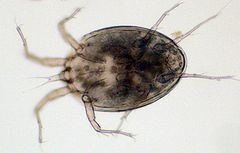Superfamily Histiostomatoidea Rank Family Subclass Acari | ||
 | ||
Similar Histiostoma, Astigmatina, Sarcoptiformes, Acaridae, Uropodidae | ||
Mites of the histiostomatidae
Histiostomatidae is a family of astigmatid mites and branches basically in a phylogenetic tree of the Astigmata.
Contents
- Mites of the histiostomatidae
- Behaviors and mouthparts of the histiostomatidae mites
- Description
- Genera
- Videos
- References
Behaviors and mouthparts of the histiostomatidae mites
Description
These mites are characterized by a very small size (about 600–900 µm in length) and a close association to arthropodes, mainly insects. A morphologically specialized instar, the deutonymph (earlier "hypopus"), is adapted to attach e.g. insects for a phoretic transport from one habitat to another. The mites use different insect groups as phoretic carriers such as beetles, flies and Hymenoptera (ants, bees and wasps). In all species, the digitus mobilis of the chelicera is reduced to small rests, and the distal pedipalp article is connected to a more or less complex membranous structure. These mouthpart modifications form an organ to feed bacteria.
Habitats are colonized by the mites such as animal dung, compost, waterfilled treeholes or the fluids of Nepenthes and Sarracenia - pitcher plants.
Genera
The family contains the following genera:
Videos
[1] Histiostomatidae-Mites: Mouthparts and Feeding von Stefan F. Wirth [2] Mites of the Histiostomatidae von Stefan F. Wirth
